
Acorn
Nature is often emulated in human craft, and pipe making is no exception. The aptly named Acorn has all the appearance of its muse. Its bowl is of conical shape, somewhat like that of the Dublin, but whereas the bowl of a Dublin tapers from rim to heel in a linear fashion, the bowl of an Acorn is, well, more like an acorn.
The Acorn’s bowl swells outward from the top, and then begins to taper, reaching a point at the bottom of the bowl, which sometimes extends below the line of the shank (a characteristic not commonly found among pipe shapes). The point at the bottom of the bowl can be sharp or rounded. Acorns are usually made with round shanks to compliment their natural bowls, and shanks can be bent or straight, though bent shanks are the mode. If bent, it is usually not more than 1/4 so. Acorns can be found in all variety of finishes and stain colors.

Apple
Often difficult to distinguish from the Author, Brandy and sometimes even the Tomato, the Apple pipe is traditionally a slightly shorter and softer version of the beloved Billiard. The more generous curvature is most noticeable at the top going toward the rim, and around the middle of the bowl, the walls of which are more convex than a Billiard’s. For those of us that failed geometry, that is to say that its walls protrude more from the chamber than those of a Billiard’s, but not as much as an Author, Brandy or Tomato.
Regardless of the confusion, Apples are very much a favorite of pipe enthusiasts and are in ample supply. Apples can be found in either the straight or bent variety, and are also commonly made as “full bent” pipes (close to a 90° shank bend, and usually featuring stouter bowls) for those who want to have a professorial air about them without actually having to grade any exams. Their shanks are very seldom anything but round, and often quite beefy. Its soft edges and medium-sized bowl give it a classic look and make it very comfortable to hold.
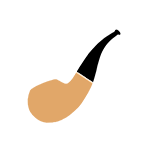
Author
A bigger brother to the Prince shape, the Author features the same flattened ball shape, but is quite a bit larger than its smaller sibling. The Author’s hefty bowl sits at the end of a burly shank that almost always has a 1/8 – 1/4 bend. Its thick walls help keep the bowl from heating up and make for a comfortable hold.
The Author is usually seen as a smooth pipe and it lends itself quite nicely to a lighter stain color or even a natural finish, simply buffed to a shine with no stain at all. The origin of the Author name quite possibly comes from the ease and comfort with which it can be clenched in the teeth, whilst hunched over, penning furiously a literary masterpiece.

Billiard
Perhaps no shape embodies that of the smoking pipe more clearly than the classic Billiard. Favored by the likes of J.R.R. Tolkien, Albert Einstein, C.S. Lewis and countless other famous pipe enthusiasts, the Billiard continues to be a well-esteemed shape by pipe smokers today. The most likely explanation for the origin of its name is the French word for stick, bille. It may have been so called because its round, straight shank was reminiscent of a billiard cue. A Billiard’s bowl is cylindrical from top to bottom, and usually measures about 1.5 – 2″ tall. Many Billiards break away from the rigid cylindrical shape, and feature bowls that curve very slightly inward at the rim and the heel. The bowl of a Billiard should also be canted forward ever so slightly (approximately 2°), which softens the overall appearance.
True to its namesake, a classic Billiard’s shank is still both round and straight, and is about as long as its bowl is tall. Tapered or saddle stems are both common on this pipe, and stems measure 2 inches in length, give or take. The Billiard’s timeless shape has served as a launching pad for many other pipe shapes over the years. The Oom Paul, Chimney, Pot, and Canadian (including all its sub-styles) all feature a Billiard shaped bowl, but are considered to be unique shapes by virtue of their respective variations. While originally a straight pipe, Billiard’s now come as 1/2 and 3/4 bent pipes as well. To no one’s surprise, the Billiard is offered in the widest range of colors and finishes possible, and virtually all pipe making entities produce their own versions of the world’s most popular pipe shape. A true classic.
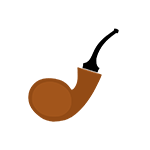
Blowfish
The Blowfish is considered a freehand shape in the world of pipe making. It is a perfect example of beautiful asymmetry; it’s organic and graceful, but by no means overly delicate. The Blowfish takes the appearance of a squished ball, having a wide, bulging profile, and a more narrow face. The carver orients the Blowfish so that the cross grain exits on the broad-sided profile of the pipe, resulting in a stunning manifestation of birdseye on one or both sides. Naturally, straight or flame grain will then flow across the narrower width of the pipe. The shank of a Blowfish should exit fluidly at the bottom of the bowl, having no interrupted or abrupt lines. The stem then exits the shank in a similar fashion, but bends gently in the opposite direction. Therefore the vast majority are created as bent pipes, and many deeply so.
Shank extensions and embellishments of horn, exotic woods, and metals are often seen on these pipes. Due to the Blowfish requiring extraordinary grain quality, this is another pipe shape that can really strain the piggy bank, and is seldom found in anything but a smooth finish.
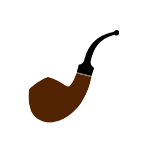
Brandy
The Brandy is one of the most popular pipe shapes in the world today, and it’s easy to see why. With easy-flowing lines and elegant proportions, the Brandy has been aesthetically groomed over the course of many decades to resemble its namesake, the brandy glass. While the shape of the bowl can vary considerably, Brandys are recognizable by their wide, rounded base, which tapers sharply to meet the comparatively narrow mouth of the chamber. More often than not, you’ll find them in a smooth finish since the shape flaunts the straight grain of a briar block extremely well.
Handmade Brandys typically display an even more voluptuous base which tapers more dramatically, on account of not being limited to the abilities of a machine to form their shape. Shanks are usually round, can be straight or slightly bent, and are usually fitted with a tapered stem, bent from 1/4 – 3/4. Less common features include a flared shank and/or army mount stem. All in all the Brandy has a classic, sophisticated appearance with a wonderful feel in hand. Just resist the urge to swirl it round and round.
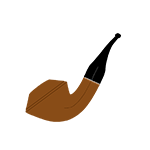
Bulldog
This well-known shape has been a favorite among many smoking pipe enthusiasts for the past several decades. Thanks to its unique bowl shape, the Bulldog is quite easily distinguishable from every other pipe shape, save for the Rhodesian, which is really a varietal of the Bulldog. The bowl of a Bulldog is essentially two cones adjoined at their bases, the top cone being abbreviated at the chamber, and the bottom cone blending into the shank. A hallmark almost always found on a Bulldog is one or more thin grooves cut into the circumference of the bowl. Each groove is usually slightly less than the width of a toothpick, and their number and placement may vary, though they are usually found near the junction of the two “cones.” Bulldogs that do not have grooves are few and far between.
Along with the bowl’s unique shape and grooves, Bulldogs are typified by a diamond-shaped shank. With the hard edges of the shank and the round walls of the bowl, it is paramount that the transition of bowl to shank be executed with skill to avoid an awkward appearance. Like the shank, the stem of a Bulldog is also diamond-shaped, with both tapered and saddle-bit stems being equally acceptable. Bulldogs make excellent candidates for combination finishes such as “partially sandblasted” pipes due to their multiple distinct surface areas created by the hard lines of the pipe’s unique shape.

Calabash
The image of a Calabash pipe is, for many, inseparable from that of the legendary investigator, Sherlock Holmes. Often simply called a “Calabash,” the name is anything but arbitrary. The calabash gourd was the original medium from which these pipes were crafted. A gourd of proper shape and size was selected, then cleaned and dried carefully before being drilled and fitted with a bowl and stem. In recent times, however, pipe makers have begun to craft these pipes out of other materials including briar, without forsaking the classic shape and unique mechanics.
Calabash pipes lay claim to a functional feature entirely distinct unto themselves. The bowl of the Calabash pipe is removable, held in place by a tension fit, or by “unscrewing” it from a threaded seat at the head of the pipe (a modern improvement). Historically the bowls were crafted in meerschaum, but are now also made from briar, ivory, or less commonly, boxwood or other suitable hardwoods. When the bowl of the Calabash is removed, one can see the cavernous interior chamber of the pipe, which allows for the smoke to become quite cool and dry before it is drawn into the mouth of the smoker. Calabashes may vary in overall size, but are easily distinguishable from other pipe shapes. The Calabash is typified by a very dramatic bend in the body of the pipe, nearly assuming the shape of a “U”, and has a drastic but gradual and uninterrupted taper from bowl to stem. The shank of the briar iteration cannot, for mechanical reasons, match the drastic bend of its gourd counterpart, but the spirit of the shape is usually carried through. A relatively long stem is often fitted to give visual balance to the otherwise top-heavy smoking instrument.

Canadian
Canadian is actually both a pipe shape, and a family of pipe shapes. The Canadian family of shapes includes the Canadian, the Lovat, the Lumberman, and the Liverpool. The Canadian is also sometimes referred to as the Canadian Billiard, because it and its entire family are sub-styles of the classic Billiard shape.
Maintaining the simple symmetry of the Billiard-style bowl, the Canadian sports a slender shank about twice the length of the bowl’s height, trimmed with a modest stem which accentuates the elegance of the pipe’s dimensions. What differentiates the Canadian from other pipes in the family is that the Canadian has an oval shank with an oval tapered stem.
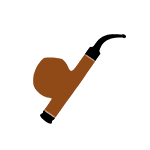
Cavalier
The Cavalier is based on the historical Tyrolean pipe, so named for its origin in the Tyrol region (modern day Italy, Austria, and Germany), but the pipe is of German descent. The distinct feature of the Cavalier pipe is that its round shank extends well below the entirety of the bowl, eventually becoming the “foot” of the pipe. The bowl is usually Billiard shaped, if only a bit more rounded, and rests atop the shank like a rose bud on a thin branch. Its draught hole is drilled all the way down to the end of the ”foot,” meaning that the draught hole stretches from the very top to the very bottom of the pipe.
The design is functional, as unwanted moisture from the tobacco is drawn out of the bowl and into the base of the pipe, where it will not reach the mouth of the smoker. The “foot” is adorned with a removable cap that allows trapped moisture to be released, and the draught hole to be easily cleaned. Not a pipe to be clenched in the mouth, the Cavalier is best smoked at home, where one can fully appreciate the nature of its design.

Cherrywood
The Cherrywood is one of the few shapes that is always a “sitter,” having a flat bottom. While it is technically a sub-style of the Poker shape, over the years pipe makers have forced its evolution to its current-day appearance, which while still bearing some visual similarities to its parent the Poker, is often quite elegant in spite of its fortitude. The Cherrywood is another thick-walled pipe, more often than not, which when added to the convenience of it sitting on its own behind, makes it a wonderful pipe to smoke while enjoying a strong beverage, reading a newspaper, or other such activities that occupy the use of one’s hands.
Cherrywood pipes are typified by their sitting position, which contrary to the upright Poker, is at an an angle, causing the bowl to lean forward. Its bowl is shaped almost like that of a tree trunk, often cylindrical, but sometimes with a slight to significant outward taper from heel to rim. In recent examples, it is not uncommon to see some asymmetry in the bowl which offers an organic aesthetic befitting of the name Cherrywood. The shank exits the pipe on the lower half of the bowl, and can be made straight or with an upward bend. The stem is bent in the opposite direction of the shank, which atop the shank not only helps to achieve a proper balance when the pipe is seated, but also takes an appearance much like that of a gnarled tree limb, further adding to the suitability of its title. This shape may originally have been a popular choice for “basket” pipes made of cherry wood, which some say is the the origin of the name.

Chimney
Let’s cut right to the chase here; you can fit a lot of tobacco in this one. A Chimney is perfect for those nights after a long, bad day at the shop or office, when you need a good hour or more to regain your sanity and composure. The Chimney is a taller derivative of the Billiard. Not too commonly found, Chimneys are usually produced by artisans, not factories, since they are in short demand.
A Chimney bowl should be about about 50% taller than that of its classic Billiard counterpart. The diameter of the bowl remains the same for the most part, as do the lengths of the shank and stem. Any and all colors and finishes that can be found for the Billiard suit the Chimney just the same!
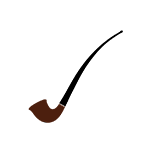
Churchwarden
Wildly popular today, thanks to the Lord of the Rings series of films, the Churchwarden’s actual origin dates back to well before Tolkien’s masterpiece was scribed. Churchwarden pipes had their debut in Europe thanks to the Austrian light cavalry who brought them to England and France during the Napoleonic Wars. One of the primary advantages (and indeed the defining feature) of the Churchwarden is the distance between the bowl and the bit. Churchwardens are very long on account of stems that reach nine inches in length or more. The smoke must travel this great distance, and so it has more time and surface area in which to cool, resulting in what many consider to be a more pleasurable smoke. This advantage, however, is met by its respective drawbacks. Churchwardens are notoriously inconvenient to carry around, and their small bowls only allow for a brief smoke. In the proper setting, however, all these drawbacks are quite easily forgotten.
Since Churchwardens are defined by the stem length rather than the bowl shape, their bowls can theoretically assume any shape. We challenge you, however, to show us an experienced pipe maker who would dangle an Oom paul or a Volcano off the end of a slender 9” stem. Prince, Dublin, and Cutty-style Churchwardens are much more sensible. Churchwardens have also been called “reading pipes,” since the extended length prevents the bowl from obstructing a reader’s view.

Cutty
There is no denying the resemblance that the Cutty bears to the clay tavern pipes of a bygone age. Delicately shaped, Cutty’s typically have not an ounce of excess briar left in place. This delicacy of shaping necessitates the use of a special drill bit for the tobacco chamber, which tapers even more drastically than a Danish conical bit, and comes to a sharp point at its tip. A special honor is paid to this pipe, in that this type of conical bit is now called the “cutty bit”.
Many Cuttys still include the “spur” at the foot of the bowl, once again hearkening back to their clay ancestors, but while the spur of a clay pipe was the remnant of the manufacturing process, the briar versions are purely nostalgic. The bowl of the Cutty is heavily canted forward, which helps differentiate it from other long-shanked pipes like the Canadian. The Cutty may sometimes display a very unique stem, which is slim, slender, and round (almost like a straw). However, the majority of modern Cuttys now sport a tapered stem, and come in many finishes.

Dublin
We’d like to contest that this was Daniel O’Connell’s favorite pipe, and that he was known to slowly pace the Liffey, puffing thoughtfully on his little charred Dublin, only stopping if to greet another passing Irishman. There is no evidence to support this claim, so I say we start the rumor!
What we know for certain about the Dublin is that it is much like a Billiard in proportions and measurements, but with walls that taper gently and evenly from a wider rim down to a narrow heel. Up top, the rim is usually flat, but Dublins can be found with a beveled rim as well. Smooth finishes are by far the most common, since the vertical walls of this pipe make a wonderful showcase for straight grain, as does the relatively wide rim for birdseye. They usually wear a tapered stem, though saddle stems are also seen. Dublins can range from straight to 3/4 bent, and just about any color or finish is more than fitting for this timeless pipe. Daniel O’Connell would be proud.

Egg
One of many pipes which finds its inspiration in an object of similar shape, the Egg is not only beautiful to behold, it is one of the most comfortable in the hand, sitting perfectly in one’s palm. A well done Egg (pun intended) can be regarded as art, and surely countless have made their way onto the shelves of high-end pipe collectors. The Egg’s bowl is usually about the size of, what else, a large hen’s egg, and is most often seen canted forward a few degrees. The transition between bowl and shank is arguably the most graceful to be found on any of the standard pipe shapes. Made famous by the Danish pipe makers, a Danish made Egg usually features a long slightly bent shank which gradually flares until it reaches the stem. Now produced by pipe makers worldwide, Eggs remain very popular among pipe Enthusiasts today, and can be found smooth, sandblasted, and rusticated.
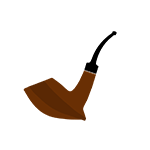
Elephant’s Foot
The Elephant’s Foot was created by the late legendary Swedish pipe maker Bo Nordh. Bo is one of the few pipe makers in the history of the craft that has been credited directly with creating not one, but two entirely new shapes. Finding a suitable block for the carving of an Elephant’s Foot is a task in and of itself. The grain must be nearly flawless in order to achieve the desired result, which is a gentle convex face covered from edge to edge in birdseye grain, the narrower flat sides of which should display perfectly contradictory straight grain. Likewise straight grain should radiate from the end of the shank toward the back of the pipe, which like the front should also have an ample endowment of birdseye grain. An Elephant’s Foot should almost always be entirely smooth, though partial sandblasting has sometimes been executed successfully.

Freehand
This is the only pipe that refuses to be described. We can talk about the evolution of shape, and comment on the influences of this pipe maker and that, but the shape of the Freehand is entirely dependent on the hand of its individual maker. When a pipe maker begins to work on a Freehand pipe, there isn’t always an established shape that he is determined to arrive upon. The piece of briar that is being worked, in some ways, has a will of its own. And so, as material is sanded away from the rough edges of the block, the grain points one way and then another, until all the excess material has been removed, and what remains is only what naturally lay within. The supernal grains that make our beloved briar so beautiful to behold, made possible only after decades of growth under the Earth, are expertly exposed by the skillful hands of the carver. Freehand pipes take many forms, many of them unsurprisingly inspired by nature, but each one tests the skill and understanding of the carver in a unique way.

Hawkbill
After laying eyes on a Hawkbill, one will realize that every pipe they have seen before had at least one thing in common; if their shanks were bent at all, they were all bent in the same direction (up). The Hawkbill’s round shank, however, is bent downward. This peculiar and seemingly nonsensical irregularity is what gives the Hawkbill its uniqueness, and not the shaping of its bowl. The Hawkbill’s bowl is usually shaped like a Brandy, Tomato, Author, or something in between. It can be made in a variety of finishes, and is usually accompanied by a short round tapered stem. Once significantly more popular than it is today, the Hawkbill has fallen from the limelight, but there are still some who nurture an admiration for the odd.

Horn
A fine Horn is one of the most elegant pipe shapes of all. With no “junction” between the bowl and shank, the lines flow gracefully back and forth along the length of the pipe, only interrupted by the meeting of bowl and stem. The defining characteristic of the Horn is its continuous and uninterrupted taper from front to back, and so one may find that Horns are created with square, round, triangular, or freely shaped bowls, having considerable variation in the finer details of appearance. The Danish master carvers are renowned for their production of stunning Horn pipes, but today the Horn has been adopted by carvers from all over the world.

Liverpool
Canadian really isn’t a proper surname for this pipe, having found its namesake in that old port city of Western England. However, the Liverpool is in fact part of the Canadian family of pipes. What differentiates the Liverpool from other pipes in the Canadian family is that the Liverpool has a round shank with a round tapered stem, making it perhaps the most conventional of the group, and right at home amongst all the classics. As with other members of the Canadian family of pipes, the length of the shank should be about twice the height of its Billiard shaped bowl.

Lovat
The Lovat is part of the Canadian family of pipes, a sub-style of the Billiard shape. What differentiates the Lovat from other pipes in the Canadian family is that the Lovat has a round shank and a round saddle stem. As with other members of the Canadian family of pipes, the length of the shank should typically be about twice the height of the bowl, but some petite variations with a greater shank to bowl ratio have proven handsome interpretations. Lovats look great sandblasted or smooth, but the highly polished finish of a smooth Lovat seems to do the trick for many connoisseurs. The Lovat is named after the various lords and barons Lovat (Lordship of Lovat), such as Brigadier-General Simon Joseph Fraser.

Lumberman
The name “Lumberman” evokes images of burly men in flannel shirts hauling freshly cut logs through coniferous forests, and yet the Lumberman pipe seems to contradict this imagery unapologetically. The Lumberman is yet another part of the Canadian family of pipes, a sub-style of the Billiard shape. What differentiates the Lumberman from other pipes in the Canadian family is that the Lumberman has an oval shank with an oval saddle stem. As with other members of the Canadian family, a slender shank graces the bowl carrying about twice the length of the bowl’s height to its end. With its slim and simple profile, it would hardly look at home in a massive calloused hand. Perhaps Canadian lumbermen are slender and gentle, and we’ve had the wrong idea all this time.

Nosewarmer
A Nosewarmer, like a Churchwarden, refers not to shape but to proportions and length. Nosewarmers, also sometimes referred to as “Stubby” pipes, are significantly shortened in overall length when compared with their standard counterparts. This is usually accomplished by cutting the shank short. The rest of the pipe, then, must follow suit. The bowl will often be shorter than if it were a standard pipe, but the shape of the bowl will not change. More often than not, Nosewarmers are only made as straight pipes, because it is difficult to form a graceful arc with so little length. It’s perfectly normal to see Billiards, Pots, Dublins, Brandys, and some other classic shapes in the form of a Nosewarmer, but many pipes are excluded from the Nosewarmer category due to the requirements of their shaping, such as Canadians, Oom Pauls, and Horns, amongst others.
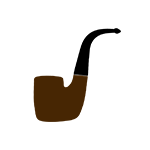
Oom Paul
Oom Pauls don’t credit their uniqueness to shape alone, but rather the marriage of shape, size, and bend. The bowl of an Oom paul is shaped like a large Billiard with a generously sized tobacco chamber. Oom Pauls are always fully bent, having a shank about the same diameter as the bowl, and are often made as “sitters.” Certainly one of the more interesting shape names of the bunch, you can likely guess that it isn’t without a story. Stephanus Johannes Paulus Kruger, better known as Paul Kruger and affectionately known as Uncle Paul (Afrikaans: “Oom Paul”) was State President of the South African Republic. Uncle Paul was often seen in public and photographs with his favorite pipe, a Hungarian, descending from his mouth. Slowly becoming synonymous with the man after which it is now named, many pipe manufacturers began applying the President’s nickname to his choice pipe shape, with many pipe makers also following suit. Over time, the name “Hungarian” faded away, and today it is widely known as the “Oom Paul”. This pipe, due to its size, seems like it was made to be smoked while relaxed and reclining, its bowl brimming with your favorite nightcap. While it certainly won’t disappoint in that capacity, the Oom Paul, because of its abruptly bent stem and low slung weight, is surprisingly quite comfortable held freely in the mouth, as Uncle Paul often demonstrated. The Oom Paul is readily available smooth, sandblasted, or rusticated, and we can’t help but feel that it would make one heck of a grandfather to grandson heirloom.
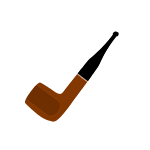
Panel
Pipes referred to as “paneled” derive their originality not from a specific shape, per se, but from a distinct aesthetic property, namely the flat panels on their bowls. Many pipes can be made with panels, including Billiards, Dublins, Brandys, Acorns, and more. What constitutes a Panel? Panels on the bowl must be even in number and symmetrically positioned, though paneled pipes with six or eight sides may have panels of varying widths. This helps differentiate a paneled pipe from a Freehand, which may have one or more panels placed at any desired interval. The original Panel was a Billiard with four paneled walls, but the feature has spread to other shapes as mentioned. A paneled Billiard with a square shank is also referred to as a Foursquare.

Poker
Named for its ability to sit steadily on the poker table while you shuffle up and deal, the Poker is made for play, but it’s an “all business” kind of pipe when it comes to shaping. Its walls are tall, and the cylindrical bowl is flat on both the top and the bottom. The round shank exits just below the bottom of the bowl, and is elongated with a simple saddle stem. The sturdy appearance of the Poker is complemented well by a skillfully rusticated finish. They are most often turned on a lathe as opposed to being shaped freely by hand, in order to achieve true symmetry. Whether you’re risking it all at the poker table or knitting a new pair of baby booties, the Poker is a perfect companion for those of us who can’t be constrained to one activity.
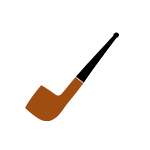
Pot
If someone sawed the top of your Billiard off, two things would result. First, you’d be forced to engage the miscreant in a round of fisticuffs. Secondly, after raining blows upon him and emerging victorious, you would find yourself in possession of a new Pot from which to smoke a celebratory bowl of your favorite blend. The Pot shape is technically a variation of the classic Billiard, but is a prime example of a shape which has become its own. Unless a Pot is made to unusually grand proportions, the limited chamber depth generally lends itself to smoking strong blends or when on the go, and so it’s a good thing that the Pot makes a handsome Nosewarmer or pocket pipe. Taking the same shaping characteristics as the Billiard, then simply removing the top half of the bowl so that the walls are about half as tall and do not taper, leaves you with a Pot. The short bowl of a Pot is hard pressed to take full advantage of the straight grain in a block of briar, so it’s not uncommon for a maker to opt for sandblasting, which when executed well becomes more of a virtue than a vice. Pots are nearly always made as straight pipes, and also make good candidates for magnum pipes./p>
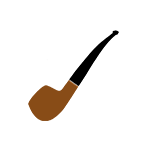
Prince
As its name suggests, this shape has royal origins. The Prince was originally fashioned for Prince Albert who would later ascend to the British throne as King Edward VII. An English dandy if ever there was one, the prince demanded elegance not offered by any shape in existence at the time. Pipe maker Emil Loewe, founder of London’s Loewe and Co., designed the shape for Prince Albert, and in doing so created an instant classic. The Prince’s design is simple and understated. It is made up of a short round bowl, accompanied by a short straight round shank, and is fitted with a long tapered stem (about 3.5”) that usually has a 1/8 bend. Loewe’s original design is rarely deviated from, but Princes can be found in a variety of finishes. Light and dark stains, smooth and sandblasted finishes, and nickel or silver banding are commonly seen on the Prince. They make excellent Churchwardens as well, on account of their pint-sized proportions, and are exceedingly comfortable to hold in the teeth. This once kingly pipe has found a place among the paupers.
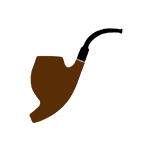
Ramses
A second entirely original shape attributed to the legendary Bo Nordh is the Ramses. It’s hard to mistake the Ramses for any other pipe shape, but bear in mind that the Cavalier, while similar in construction in some ways, has a round tube-like shank and base, while the Ramses shank and base are wider and flatter. Together, they have the appearance of a gently cupped hand holding the bowl. The Ramses is a very difficult pipe to form. The grain must be oriented in a very precise manner to achieve a beautiful result, much like Bo’s other original shape, the Elephant’s Foot. The tobacco chamber runs nearly parallel to the stem, which makes it very difficult to drill proper channel for the smoke and still maintain good smoking mechanics. To combat this, a true Ramses has the draught hole drilled so that it ends a few tenths of a millimeter away from the side and bottom of the tobacco chamber. Another hole is then made through the side of the tobacco chamber which meets the draught hole. This method allows the smoker to smoke the Ramses all the way down to the bottom of the bowl, which is a difficult thing to do with many fully bent pipes. Pipe makers are beginning to experiment with different finishes, but the Ramses seems most comfortable in a smooth finish. Bo Nordh was a true pioneer of both mechanics and artistry, the combination of which gave us the Ramses pipe, and what a beautiful pipe it is.

Rhodesian
Although the Rhodesian differs only slightly from the Bulldog, it is a very popular shape in its own right. A Rhodesian is essentially a Bulldog, except where the Bulldog’s shank is diamond shaped, the Rhodesian’s is round, and in very rare cases, oval shaped. Much like its parent pipe, the Rhodesian is very difficult if not impossible to create without the use of a lathe, due to the precise rings that are turned into the bowl. The round shank of the Rhodesian tends to impart a chubbier look to the piece overall, a homebody counterpart to the out-and-about Bulldog.
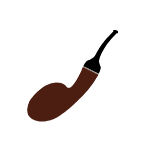
Squat Tomato
As nomenclature goes, this is about as straight-forward as it gets. Much like a Tomato is born by figuratively squishing a spherically shaped pipe, so a Squat Tomato is just a squashed Tomato pipe. The added “squashing” leads to a very thickly walled bowl, which helps maintain a comfortable temperature in hand while smoking. Light to medium bends are often seen in the shank, and it is quite commonplace to spot one with a white or black bamboo shank extension. Bowl sizes tend to vary on this one, as do the stems, which can range from tapered to saddle to fancy. Being that their shanks are almost always round or oval, however, you really wouldn’t see any with diamond shaped stems. You’d also be hard-pressed to find a factory made Squat Tomato, as they are not practical to cut on a machine. Becoming a bit more commonplace today, the Squat Tomato is stunning with a dark sandblasted finish, a contrasting shank extension, and a smooth rim.

Tomato
The Tomato shape is usually crafted to look somewhat like a squished ball. Its bowl can either be symmetrically shaped, or a bit more organic/Tomato-like, if you will. Due to the bowl’s shape and thick walls, it is very comfortable to hold and keeps the scorching heat within the chamber at bay. Their shanks are nearly always round, although some pipe makers have made Tomatoes with triangular shanks, the flat bottom of which flows naturally into the wide lower half of the bowl. The shape of the bowl lends itself to having a bent shank, but the straight shank variety, if done well, can be equally as handsome. Tomatoes take well to skillful sandblasting!
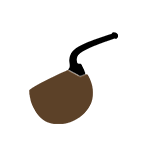
Vest Pocket
This bizarre little smoking instrument is designed to fit in the pocket of a vest, as the name implies. The bowl of the pipe is rather unique in that the chamber is actually oval shaped, and not round. All the edges on a Vest Pocket are smoothed considerably to prevent the pipe from snagging the material of your clothing when taking it out or putting it away. You’ll realize how practical a feature that is once you try to stuff a rusticated Poker in the ol’ pocket. Aside from the oval smoking chamber, the stem is surely the most unique element of the Vest Pocket pipe. It can twist 180° so that it does not protrude from the pipe, and when folded, it is indeed a wee little package.
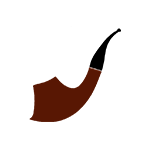
Volcano
Even to the untrained eye, it’s not too difficult to spot a Volcano in the crowd, since its inspiration is taken from an iconic earth shattering phenomenon. If it looks like a volcano, it’s probably a Volcano, but there are some basic guidelines to understanding the shape. First off, the grain orientation is very important with the Volcano shape. The pipe should display straight or flame grain radiating from the top and center of the bowl, and ideally an eye-catching exhibition of birdseye grain on the bottom. The shank should be bent upwards, equal to or greater than the stem in length, and more often than not, the bottom of the shank will be flush with the bottom of the bowl, creating a long and flowing line from front to back. Flaring shanks with extravagant extensions have become quite commonplace, and due to the nature of the pipe’s showcasing of grain, some pipe makers choose only to use rare and extraordinary pieces of briar when making Volcanos. Finer examples of this shape can be some of the most expensive pipes on the international market, easily running in the $1,000 to $2,000 range and more. Rustication of a Volcano is not recommended, and is rarely seen, but both sandblasted and smooth Volcanos can be jaw-dropping works of craftsmanship. When sandblasted, the artisan carefully ensures that the underside of the pipe is kept perfectly smooth to preserve the stunning birdseye grain, making for an exceptional contrast to the rugged top.
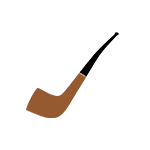
Zulu
The Zulu is somewhat of a rare breed among pipe shapes, seemingly inhabiting the limbo between Dublin and Billiard. When well-crafted, however, this shape has an unmistakable character all its own. The bowl of a Zulu is daintier than a Dublin or Billiard but may display some similarities to either or both in terms of shaping. Its greatest distinguishing feature is the more dramatic forward cant of its bowl, along with its straight shank and slightly bent stem. The shank of a Zulu is usually round and stems are almost exclusively tapered. Zulu pipes have also been referred to using their other aliases: the Woodstock and the Yachtsman. Like the Prince, its slight bend and overall proportions make the Zulu among the choicest of pipes to hold freely in the mouth. It wouldn’t be a stretch to imagine an old wind weathered sailor hoisting the lines with his Zulu clenched between his teeth.
